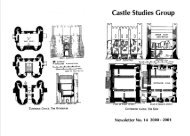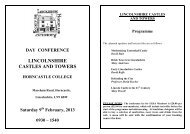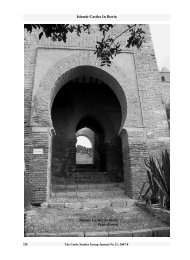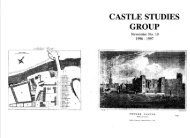Machicolation: some postscripts. - Castle Studies Group
Machicolation: some postscripts. - Castle Studies Group
Machicolation: some postscripts. - Castle Studies Group
You also want an ePaper? Increase the reach of your titles
YUMPU automatically turns print PDFs into web optimized ePapers that Google loves.
<strong>Machicolation</strong>: <strong>some</strong> <strong>postscripts</strong>.tower was unlikely to be attacked unless abreach had been opened up. Such a talltower, weakened by the openings of machicolationhalfway up in addition to those atthe top, as well as other arrow or gun loops,must have been very vulnerable to cannonfire, just what was not wanted. This was nota design that would have a future.A strange arrangement, but thereis <strong>some</strong> evidence that this was not unique.In the background of Giorgione’s CastelfrancoMadonna of around 1503, there is astrange tower apparently with a run ofmachicolation just over halfway up, whatappears to be a hourding or a drop-boxmachicolation in association with a doorway(or it might just be a balcony) furtherup and at the top, what appears to be atimber oversailing construction of hourdingsdiagonally propped in timber, with apitched roof (Fig. 7). The whole looks ratherlike a structure that has been extendedupwards and adapted over time. Possibly itis Giorgione’s fantasy and no more, but it issuggestive that multiple layers of machicolationjust might have existed in Venetianterritory as well as in Sforza lands.At the heart of Sforza territory, thecastle in Milan (1450 onwards) shows whatmight be thought of as the very opposite ofthe tower at Soncino: a robust machicolatedtower (the Torre del Filarete,) sportingabove its principal roof a smaller tower,again with machicolation and on top of thatin turn, wedding-cake like, two more turrets,or a belvedere and a lantern (Fig. 8).The lower range of machicolationis clearly usable. The upper range, if weagree that firing missiles diagonallythrough the openings is a way of usingmachicolation, could be of use too, but ifdouble the firepower was wanted, <strong>some</strong>more suitable building form could surelyhave been found. Missiles dropped fromthis upper towerlet would of course kill orinjure fellow defenders. The comparativelysmall projection of the upper machicolationreinforces the idea that this is in fact adecorative element, part of an architectonicwhole; the upper parts, slender and tall, arevulnerable to cannon fire. The fightingplatform incorporating the lower machicolationseems to be two storeys high, withtwo levels of cannon ports as well as crenellation.A demonstration of power andstatus is what this tower is all about.The tower-on-tower arrangementdiminishing upwards is of course quitecommon, but few other towers are quite soelaborate. In Siena, the Torre del Mangiahas makes a gesture towards machicolationon its upper recessed storey, but this isclearly decorative. The tower of the Palazzodella Signoria in Florence might justhave been useful in defence after thepalazzo’s courtyard had fallen, as well asadding to the first line of defence, but thecourse beneath the topmost crenellation ismerely decorative.These Milanese and Tuscan examplesof doubled machicolation diminishingupwards seem to be largely aboutshow, but they do have a functional ancestor,a tower at Lanuvio in Lazio, apparentlybuilt in the early 15th century, possiblyby altering and extending a round Romantower (Fig. 9). Here the relative proportionsof lower and upper towers and thelines of fire that are implied suggest thatboth ranges of machicolation could havebeen used at the same time, the upper rangebeing used to shoot at an angle of <strong>some</strong> 20 ofrom the vertical over the heads of thedefenders below. There has been considerablerepair, restoration and fairly recent(WWII) damage; many of the original detailsare now unclear (indeed, apparentlyaltered) but the tower’s appearance is formidable.There probably are other examplesof this arrangement, but there aremany more of simple, un-machicolatedsmaller towers rising above the crenellationof towers, which is the commoner arrangement.The <strong>Castle</strong> <strong>Studies</strong> <strong>Group</strong> Journal No 24: 2010-11 220
















